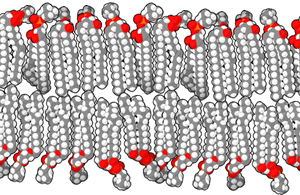What factors affect membrane fluidity?
- Fatty acid tail length: The longer the tail, the less fluid the membrane.
- Temperature: As temperature decreases, membranes become less fluid. This is because the kinetic energy of molecules in the membrane decreases, causing them to move around less.
- Fatty acid saturation: The more unsaturated the phospholipid tails, the more fluid the membrane. Unsaturated tails contain double bonds, causing them to be bent and fit together loosely. Saturated tails pack together more closely, reducing fluidity.
- Cholesterol: Cholesterol molecules fit between phospholipid molecules in animal cell membranes.
- At high temperatures, they strengthen the membrane by getting in between the phospholipid molecules and reducing fluidity.
- At low temperatures, cholesterol prevents the phospholipid tails from packing too closely together, increasing membrane fluidity and helping cells survive colder temperatures.
